P.C. Pathak, J.@mdashOne of the defendants had filed this appeal u/s 96 of the Code of Civil Procedure.
2. The respondent No. 1 filed a suit for damages against the appellant and respondents 2 to 5 on the allegation that while constructing the fifth storey over the house of which she occupies the ground floor, a labourer as also a part of the wall fell on her car, which was parked in front of her house. As a result of that, the car was damaged substantially. She claimed damages amounting to Rs. 15, 000/-.
3. The defendants denied the claim in toto. They submitted that the house in question belongs to Subhash Chand, the separated son of the appellant. They also denied that the construction was in any manner supervised by the appellant. They also submitted that the car was injured and the insurance company had already compensated the loss.
4. Learned trial Court, on a finding that the appellant was an occupier of the building in question and was in charge of the construction work, passed a decree of Rs. 5000/- against him alone. Hence this appeal.
5. It was argued that the finding on issue No. 19 is contrary to the findings on issues 16, 17 and 18, wherein the trial Court held that subhash Chand is the owner of the disputed house ever since the Civil Court decreed his claim on the basis of partition deed Ex.D-7 dated 26.3.1970. The Court also held that Subhash Chand lived separately from the appellant. There is much force in the said statement. In order to fix the liability for damages, the plaintiff did not plead that the appellant was occupier of the building and that he was in charge of the construction work on the relevant date i.e. 2.2.1975. Instead, the plea in para 4 of the plaint is that the defendants were getting constructed the fifth storey of their building. The learned trial Court exonerated the respondents 2 to 5 but fixed the liability on the appellant alone. Even after defendants'' denial of their liability, the plaintiff did not amend the plaint so as to demonstrate how and why the appellant was liable for the damages. In the circumstances, the statement of Dr. Mangal Chand Naik (P.W. 11) to the effect that the appellant was occupier and was in charge of the construction work, cannot be accepted. It is well settled that oral evidence, in the absence of any foundation in the plea, cannot be acted upon. The finding of the trial Court on issue No. 19 is also contrary to its own findings on issues Nos. 16, 17 and 18 wherein the same Court held that the suit house is owned by Subhash Chand. If this finding is sustained, the plaintiff cannot claim any damages from the appellant, who is neither the owner nor a person in charge of the construction work.
6. The respondent No. 1 has filed cross-objection for enhancing the quantum of damages and also the award of interest.
7. In view of the finding that the appellant was neither owner nor is there any proof to show that the appellant was a contractor in charge of the construction work, no liability can be fastened on the appellant.
8. The appeal is allowed, the judgment and decree passed by the trial Court are hereby set aside and instead, the suit is dismissed with costs. Cross-objection also fails and is hereby dismissed. Counsel''s fee, according to schedule, if certified.

